Removal instructions for the Rhadamanthys stealer-type malware
TrojanAlso Known As: Rhadamanthys malware
Get free scan and check if your device is infected.
Remove it nowTo use full-featured product, you have to purchase a license for Combo Cleaner. Seven days free trial available. Combo Cleaner is owned and operated by RCS LT, the parent company of PCRisk.com.
What kind of malware is Rhadamanthys?
Rhadamanthys is a stealer-type malware, and as its name implies - it is designed to extract data from infected machines.
At the time of writing, this malware is spread through malicious websites mirroring those of genuine software such as AnyDesk, Zoom, Notepad++, and others. Rhadamanthys is downloaded alongside the real program, thus diminishing immediate user suspicion. These sites were promoted through Google ads, which superseded the legitimate search results on the Google search engine.
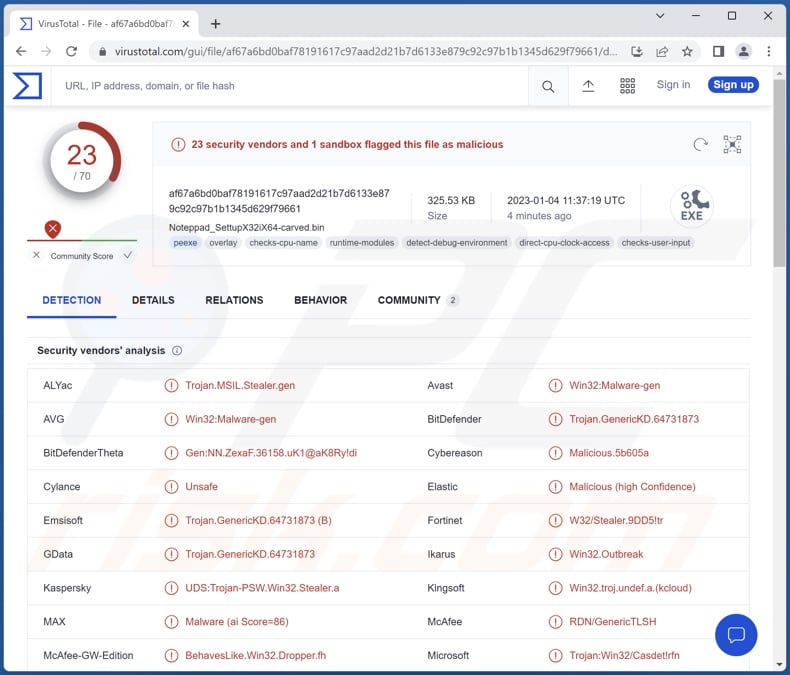
Rhadamanthys malware overview
Following successful infiltration (often alongside legitimate software that the victim intends to install), Rhadamanthys begins by gathering relevant device data. Information of interest can include (but is not limited to): device name, model, Operating System version, OS architecture, hardware details, installed software, IP address, etc.
The Rhadamanthys program is capable of executing certain PowerShell commands. It also targets document files, the theft of which (depending on the sensitivity of their data) can cause severe issues for victims.
This stealer also targets cryptocurrency wallets. It attempts to extract the passwords/passphrases of cryptowallets in order to take possession of them and the funds stored therein.
It must be noted that malware developers often improve upon their creations. Hence, potential future iterations of Rhadamanthys could target a broader range of data (e.g., log-in credentials and/or finance-related information from various browsers and apps, etc.) or have additional/other functionalities.
In summary, the presence of stealer-type malware like Rhadamanthys on devices can result in serious privacy issues, significant financial losses, and even identity theft.
If you suspect that your device is already infected with Rhadamanthys (or other malware), we highly recommend using an anti-virus to remove it without delay.
| Name | Rhadamanthys malware |
| Threat Type | Trojan, stealer, password-stealing virus, banking malware, spyware. |
| Detection Names | Avast (Win32:Malware-gen), Combo Cleaner (Trojan.GenericKD.64731873), ESET-NOD32 ( Win32/TrojanDownloader.Agent.GPZ), Kaspersky (UDS:Trojan-PSW.Win32.Stealer.a), Microsoft (Trojan:Win32/Casdet!rfn), Full List Of Detections (VirusTotal) |
| Related Domains and VirusTotal Detections | install-anydesk[.]com (VT), istaller-zoom[.]com (VT), zoom-for-desktop[.]com (VT), anydesk-for-desktop[.]com (VT) |
| Symptoms | Trojans are designed to stealthily infiltrate the victim's computer and remain silent, and thus no particular symptoms are clearly visible on an infected machine. |
| Distribution methods | Infected email attachments, malicious online advertisements, social engineering, software 'cracks'. |
| Damage | Stolen passwords and banking information, identity theft, the victim's computer added to a botnet. |
| Malware Removal (Windows) |
To eliminate possible malware infections, scan your computer with legitimate antivirus software. Our security researchers recommend using Combo Cleaner. Download Combo CleanerTo use full-featured product, you have to purchase a license for Combo Cleaner. 7 days free trial available. Combo Cleaner is owned and operated by RCS LT, the parent company of PCRisk.com. |
Stealer-type malware examples
We have analyzed thousands of malware samples; Demon, FateGrab, StealDeal, RisePro, and CryptoStealer are merely some of our latest articles within the stealer category.
There are many types of malware; for example, those designed to steal information, infect devices with additional malicious programs/components, encrypt data and demand ransoms for decryption, etc. It must be emphasized that regardless of how malicious software operates – its presence on a system endangers device integrity and user safety. Therefore, all threats must be removed immediately upon detection.
How did Rhadamanthys infiltrate my computer?
Malware is most commonly distributed by employing phishing and social engineering techniques. Malicious programs are usually disguised as or bundled with ordinary content. The observed Rhadamanthys campaigns were not an exception to this.
The stealer in question was noted being proliferated through fake websites imitating those of legitimate software (e.g., AnyDesk, Zoom, Notepad++, etc.). The malicious sites were promoted through Google advertisements, which appeared as the topmost search results in the Google search engine. When a victim made a download from such a website, they downloaded both the genuine program and the Rhadamanthys stealer.
However, this malware might be distributed using other methods as well. The most popular proliferation techniques include: online scams, malvertising, malicious attachments/links in spam mail (e.g., emails, DMs/PMs, SMSes, etc.), untrustworthy download sources (e.g., freeware and free file-hosting websites, P2P sharing networks, etc.), drive-by (stealthy/deceptive) downloads, illegal software activation tools ("cracks"), and fake updates.
How to avoid installation of malware?
We strongly advise exercising caution with incoming emails and other messages. The attachments and links found in suspicious/irrelevant mail – must not be opened, as they can be malicious and cause system infections.
It is just as important to be careful when browsing since fake and dangerous online content usually appears legitimate and innocuous.
Additionally, all downloads must be made from official and verified sources. Another recommendation is to activate and update programs with tools provided by genuine developers, as illegal activation ("cracking") tools and fake updates can contain malware.
We must stress the importance of having a reputable anti-virus installed and kept updated. Security programs must be used to perform regular system scans and to remove detected threats and issues. If you believe that your computer is already infected, we recommend running a scan with Combo Cleaner Antivirus for Windows to automatically eliminate infiltrated malware.
Screenshot of a fake AnyDesk website used to distribute Rhadamanthys malware:
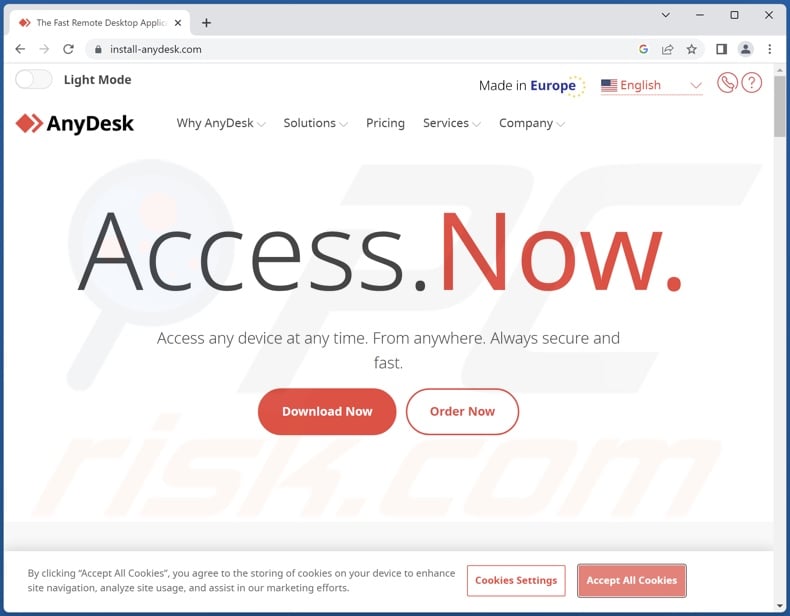
Screenshot of a Google advertisement promoting the fake AnyDesk website:
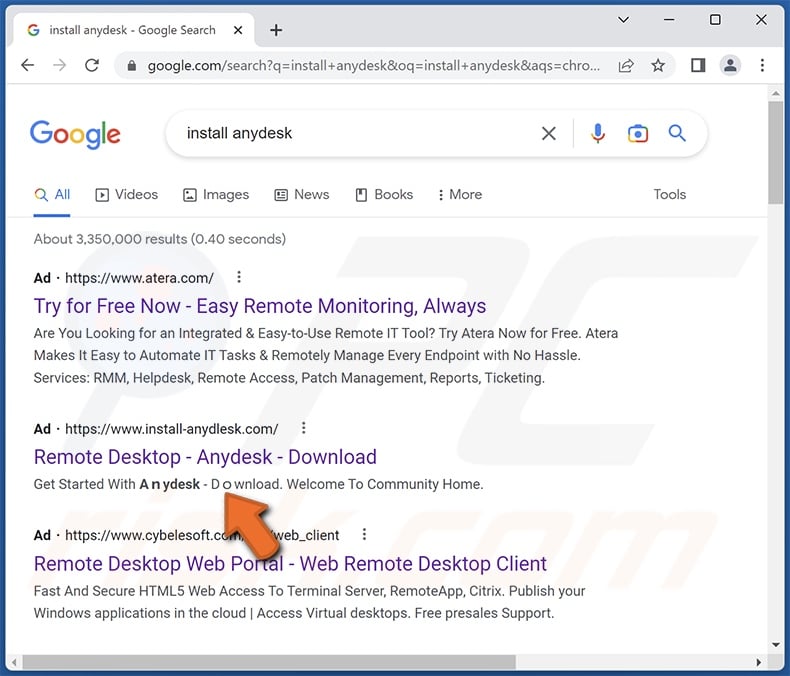
Screenshot of an image used in the Rhadamanthys malware's promotional material:
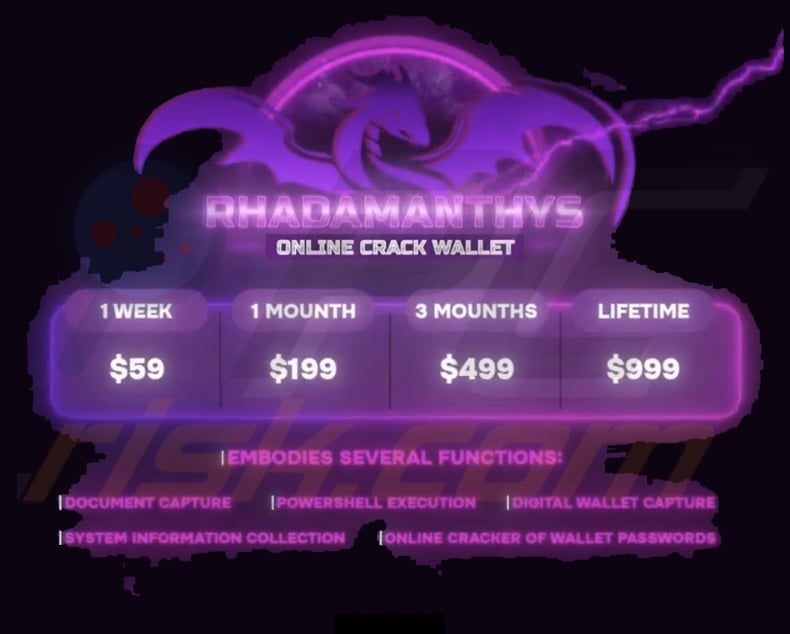
Example of a spam email spreading Rhadamanthys stealer:
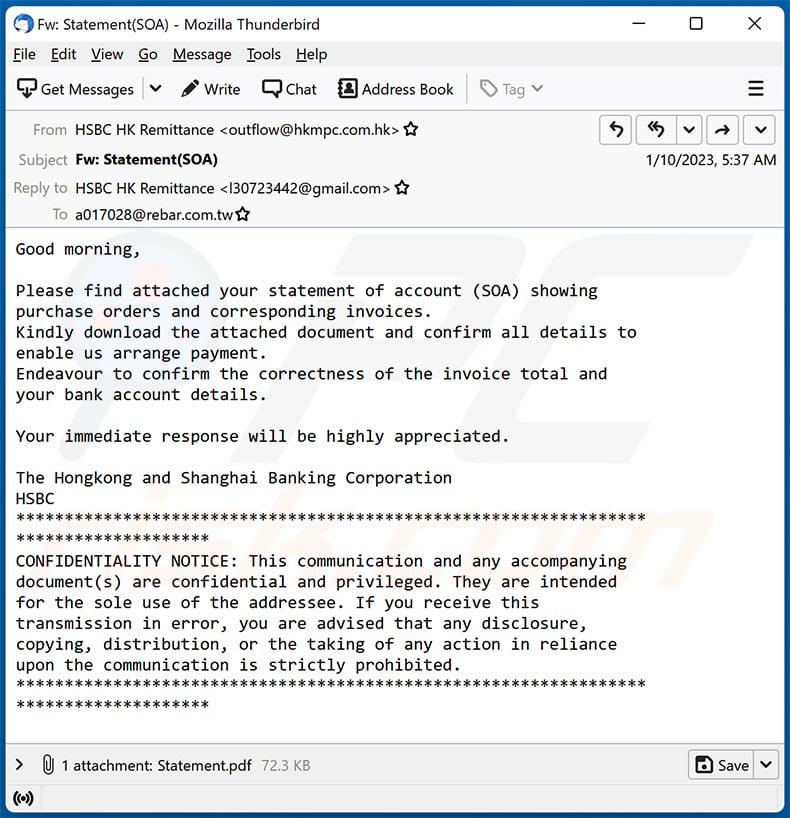
Text presented within:
Subject: Fw: Statement(SOA)
Good morning,
Please find attached your statement of account (SOA) showing
purchase orders and corresponding invoices.
Kindly download the attached document and confirm all details to
enable us arrange payment.
Endeavour to confirm the correctness of the invoice total and
your bank account details.Your immediate response will be highly appreciated.
The Hongkong and Shanghai Banking Corporation
HSBC
Screenshot of the PDF attachment containing a link to malicious executable:
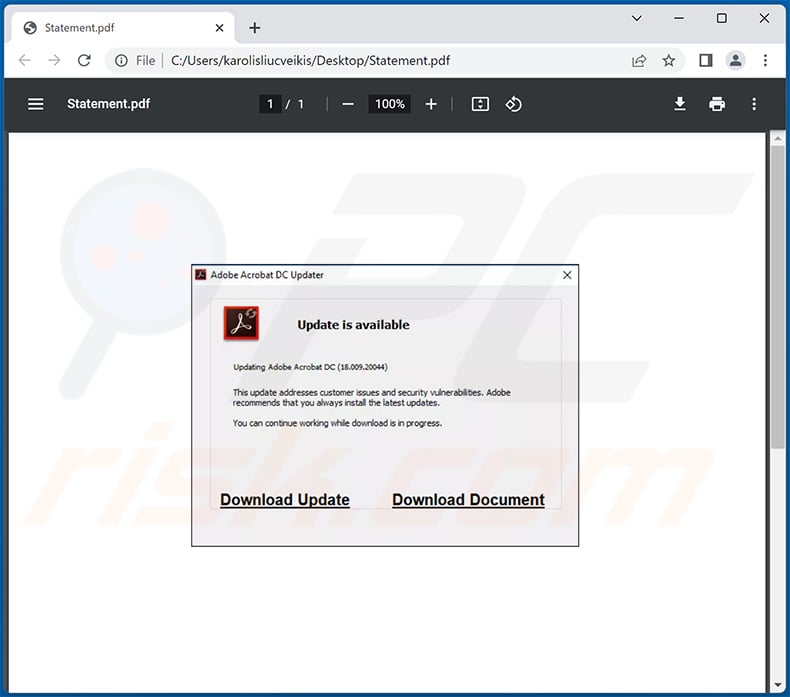
Screenshot of a fake BitTorrent download website (bittorrent-official[.]com) used to spread Rhadamanthys stealer:
![Fake BitTorrent download website (bittorrent-official[.]com) spreading Rhadamanthys stealer](/images/stories/screenshots202302/rhadamanthys-stealer-update-2023-02-23-fake-bittorent-site.jpg)
Update 18 December 2023: The creators of Rhadamanthys malware recently launched two versions, introducing improvements like enhanced stealing capabilities and evasion techniques. The newly implemented plugin system is a significant addition, enabling customization for specific distribution requirements.
This modular framework empowers cybercriminals to deploy personalized plugins to evade security measures. Among these, the plugin captures victim credentials during RDP login attempts.
Also, improvements encompass enhanced stub construction, client execution processes, fixes for cryptocurrency wallet targeting, and the acquisition of Discord tokens. Notable upgrades also include advanced data stealing from browsers, revised user panel search settings, and an option to modify Telegram notifications.
In addition, threat actors have reportedly rolled out a new variant featuring a clipper plugin that manipulates clipboard data to redirect cryptocurrency payments to threat actors. This variant includes Telegram notification options for transmitting wallet details and seeds through an exfiltrated ZIP file.
Furthermore, it possesses the capability to recover deleted Google Account cookies. Notably, the variant is equipped to bypass Windows Defender.
Update November 8, 2024: Recently, a new phishing campaign delivering the latest version of the Rhadamanthys stealer (0.7) has been spotted. This campaign uses a copyright theme to target regions like the U.S., Europe, East Asia, and South America, impersonating companies, mostly in the Media, Software, and similar sectors.
The emails are customized for each target and sent from different Gmail accounts. The new campaign seems to use automation to distribute phishing lures. It is also likely that threat actors employ AI tools.
Update 24 February 2025: The Rhadamanthys malware is being spread through MSC extension files. These files exploit two methods: one leveraging a vulnerability in the apds.dll file (CVE-2024-43572), and another using Console Taskpad commands in Microsoft Management Console (MMC). The latter method involves downloading and executing malicious PowerShell scripts, which deploy the Rhadamanthys malware.
Update May 20, 2025 – new variant of Rhadamanthys stealer has been discovered. This version has been optimized and has improved stability, reliability, and operation. The stealer now has an x64 variant. Its database operation process has been redesigned. Repeated execution of the malware on the same system no longer occurs, thus stolen data is not sent multiple times. Other changes include CPU usage optimization, new process injection, device and browser data collection enhancements, and so on.
Update October 23, 2025 - Cyber criminals are spreading Rhadamanthys stealer using the ClickFix method. Here's an example of a malicious ClickFix site used to spread Rhadamanthys:
![ClickFix website (xpoalswwkjddsljsy[.]com) used to spread Rhadamanthys stealer](/images/stories/screenshots202510/rhadamanthys-stealer-update-2025-10-23-clickfix-site.jpg)
Instant automatic malware removal:
Manual threat removal might be a lengthy and complicated process that requires advanced IT skills. Combo Cleaner is a professional automatic malware removal tool that is recommended to get rid of malware. Download it by clicking the button below:
DOWNLOAD Combo CleanerBy downloading any software listed on this website you agree to our Privacy Policy and Terms of Use. To use full-featured product, you have to purchase a license for Combo Cleaner. 7 days free trial available. Combo Cleaner is owned and operated by RCS LT, the parent company of PCRisk.com.
Quick menu:
- What is Rhadamanthys?
- STEP 1. Manual removal of Rhadamanthys malware.
- STEP 2. Check if your computer is clean.
How to remove malware manually?
Manual malware removal is a complicated task - usually it is best to allow antivirus or anti-malware programs to do this automatically. To remove this malware we recommend using Combo Cleaner Antivirus for Windows.
If you wish to remove malware manually, the first step is to identify the name of the malware that you are trying to remove. Here is an example of a suspicious program running on a user's computer:

If you checked the list of programs running on your computer, for example, using task manager, and identified a program that looks suspicious, you should continue with these steps:
 Download a program called Autoruns. This program shows auto-start applications, Registry, and file system locations:
Download a program called Autoruns. This program shows auto-start applications, Registry, and file system locations:

 Restart your computer into Safe Mode:
Restart your computer into Safe Mode:
Windows XP and Windows 7 users: Start your computer in Safe Mode. Click Start, click Shut Down, click Restart, click OK. During your computer start process, press the F8 key on your keyboard multiple times until you see the Windows Advanced Option menu, and then select Safe Mode with Networking from the list.

Video showing how to start Windows 7 in "Safe Mode with Networking":
Windows 8 users: Start Windows 8 is Safe Mode with Networking - Go to Windows 8 Start Screen, type Advanced, in the search results select Settings. Click Advanced startup options, in the opened "General PC Settings" window, select Advanced startup.
Click the "Restart now" button. Your computer will now restart into the "Advanced Startup options menu". Click the "Troubleshoot" button, and then click the "Advanced options" button. In the advanced option screen, click "Startup settings".
Click the "Restart" button. Your PC will restart into the Startup Settings screen. Press F5 to boot in Safe Mode with Networking.

Video showing how to start Windows 8 in "Safe Mode with Networking":
Windows 10 users: Click the Windows logo and select the Power icon. In the opened menu click "Restart" while holding "Shift" button on your keyboard. In the "choose an option" window click on the "Troubleshoot", next select "Advanced options".
In the advanced options menu select "Startup Settings" and click on the "Restart" button. In the following window you should click the "F5" button on your keyboard. This will restart your operating system in safe mode with networking.

Video showing how to start Windows 10 in "Safe Mode with Networking":
 Extract the downloaded archive and run the Autoruns.exe file.
Extract the downloaded archive and run the Autoruns.exe file.

 In the Autoruns application, click "Options" at the top and uncheck "Hide Empty Locations" and "Hide Windows Entries" options. After this procedure, click the "Refresh" icon.
In the Autoruns application, click "Options" at the top and uncheck "Hide Empty Locations" and "Hide Windows Entries" options. After this procedure, click the "Refresh" icon.

 Check the list provided by the Autoruns application and locate the malware file that you want to eliminate.
Check the list provided by the Autoruns application and locate the malware file that you want to eliminate.
You should write down its full path and name. Note that some malware hides process names under legitimate Windows process names. At this stage, it is very important to avoid removing system files. After you locate the suspicious program you wish to remove, right click your mouse over its name and choose "Delete".

After removing the malware through the Autoruns application (this ensures that the malware will not run automatically on the next system startup), you should search for the malware name on your computer. Be sure to enable hidden files and folders before proceeding. If you find the filename of the malware, be sure to remove it.

Reboot your computer in normal mode. Following these steps should remove any malware from your computer. Note that manual threat removal requires advanced computer skills. If you do not have these skills, leave malware removal to antivirus and anti-malware programs.
These steps might not work with advanced malware infections. As always it is best to prevent infection than try to remove malware later. To keep your computer safe, install the latest operating system updates and use antivirus software. To be sure your computer is free of malware infections, we recommend scanning it with Combo Cleaner Antivirus for Windows.
Frequently Asked Questions (FAQ)
My computer is infected with Rhadamanthys malware, should I format my storage device to get rid of it?
No, Rhadamanthys stealer's removal does not require formatting.
What are the biggest issues that Rhadamanthys malware can cause?
The threats posed by a malicious program depend on its capabilities and the cyber criminals' modus operandi. Rhadamanthys is a stealer – a type of malware designed to stealthily obtain sensitive information from infected systems. Typically, these kinds of infections can result in severe privacy issues, financial losses, and identity theft.
What is the purpose of Rhadamanthys malware?
In most cases, malware is used to generate revenue at victims' expense. However, cyber criminals can also use the software to amuse themselves, carry out personal vendettas, disrupt processes (e.g., websites, services, companies, organizations, etc.), and launch politically/geopolitically motivated attacks.
How did Rhadamanthys malware infiltrate my computer?
Rhadamanthys has been notably spread through malicious websites disguised as those of legitimate programs (e.g., AnyDesk, Zoom, Notepad++, etc.), which were pushed through Google ads. However, other distribution methods are not unlikely.
Malware is most widely proliferated via drive-by downloads, spam emails/messages, dubious download channels (e.g., freeware and third-party sites, P2P sharing networks, etc.), online scams, malvertising, illegal software activation tools ("cracks"), and fake updates. Additionally, some malicious programs are capable of self-spreading through local networks and removable storage devices (e.g., USB flash drives, external hard drives, etc.).
Will Combo Cleaner protect me from malware?
Yes, Combo Cleaner is capable of detecting and eliminating practically all known malware infections. It must be stressed that running a complete system scan is essential – since sophisticated malicious programs typically hide deep within systems.
Share:

Tomas Meskauskas
Expert security researcher, professional malware analyst
I am passionate about computer security and technology. I have an experience of over 10 years working in various companies related to computer technical issue solving and Internet security. I have been working as an author and editor for pcrisk.com since 2010. Follow me on Twitter and LinkedIn to stay informed about the latest online security threats.
PCrisk security portal is brought by a company RCS LT.
Joined forces of security researchers help educate computer users about the latest online security threats. More information about the company RCS LT.
Our malware removal guides are free. However, if you want to support us you can send us a donation.
DonatePCrisk security portal is brought by a company RCS LT.
Joined forces of security researchers help educate computer users about the latest online security threats. More information about the company RCS LT.
Our malware removal guides are free. However, if you want to support us you can send us a donation.
Donate
▼ Show Discussion